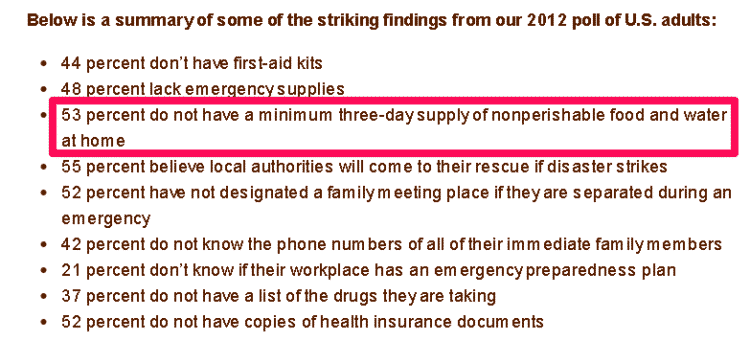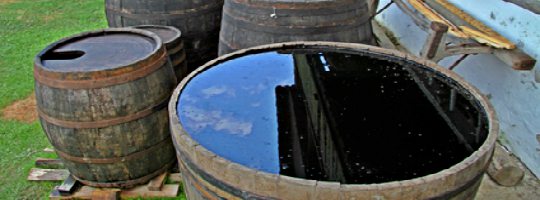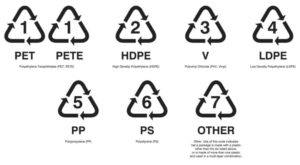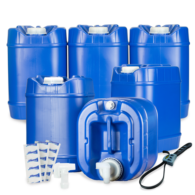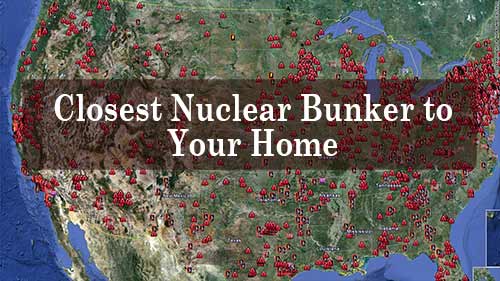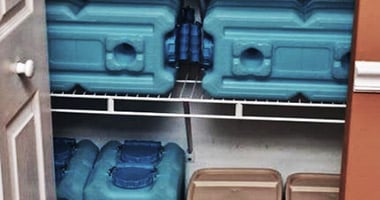
Sure, it’s NOT rocket science.
But if you don’t take the time to learn the best solutions and mistakes you could easily ruin your most critical emergency supply.
Plus, it’s easy to overlook the obvious and get your priorities mixed up.
- Do you really need another survival watch, tactical pen, or survival gas mask?
- Or is it time to invest in long-term freeze-dried survival food?
- Is an underground survival bunker really your first step?
- Or should you start with something smaller?
Like, a life-saving TACT bivvy…
One prep item that’s way too often overlooked is long-term water storage.
How do I know this? Because a 2012 poll of U.S. adults found that 53% of US homes don’t have at least three days’ worth of non-perishable food and water in their homes – 53%!
So, when SHTF and widespread panic sets in the first resources you should have plenty of is food and water.
The second thing you’ll want is a few good defense firearms and lots of ammunition. Why? To defend what’s yours and keep desperate neighbors from trying to relieve you of your vital supplies – (i.e. H2O).
It’s an absolute shame more people don’t stock up on some water. And it’s incredibly irresponsible if you don’t.
I believe, the reason more people don’t stock up on water is that it’s so prevalent in our daily lives. It’s so widely available today we all assume it’ll always be around.
Don’t make this mistake.
As A Way To Introduce You To Skilled Survival, We’re Giving Away Our #78 Item Complete Prepper Checklist. Click Here To Get Your FREE Copy Of It.
In a widespread disaster (of any sort), the first two public resources to shut down will be water and grid power. Human beings can survive without electricity – we cannot, however, survive long without water.
This means, you best start storing water in your home. It’s arguably “the most important” survival resource.
So, make sure you’re stockpiling some.
But not only that, but you also need to do it RIGHT. B
You can’t just collect rain off your roof in old milk jugs, cap them off, and put them away for six years. It won’t be safe to drink exactly when you need it most.
If it’s not stored correctly, it can (and will) become toxic.
So, let’s talk about emergency water storage for the long haul, for survival in a major widespread emergency.
How NOT To Store Water
Let’s get some misconceptions out of the way.
First, just because the water is clear doesn’t mean it’s safe to drink. Contaminants are often colorless, and no one likes drinking poison (or parasites).
Two, water DOES NOT have a real expiration date. But that doesn’t mean that you can rely on the same water stored in the same container forever – even if stored in perfect conditions.
And three, yes, you can die if you do this wrong. It’s simple to store water safely for the long term, but if you do it wrong, you’re putting your life on the line.
At the very least, you’ll get sick, and getting sick or injured sucks (especially in a survival situation).
For that exact reason, before we get into how you should store water I’m going to explain how you should NOT.
DO NOT store water in anything besides food-grade water storage containers.
I am going to repeat that throughout this article so many times it is going to make your head hurt. ONLY FOOD-GRADE WATER STORAGE CONTAINERS!
I know, those Home Depot buckets are cheap. They are also damn near indestructible, you can buy lids for them, and they’re an awesome bright orange color. But you shouldn’t store water in them. You should never store water in anything not made for holding food/water.
You can tell if a container is food grade in several ways:
- Plastics #1, 2, 4, and 7 are the plastics used for food-grade containers. You can find this number in the little triangular recycle symbol on the bottom.
- Also on the bottom, there’ll be a symbol indicating the container safe to freeze or store in a pantry.
- The container often says on the package when you buy it, “Freezer, Refrigerator, Pantry Safe.” Or something like that to indicate that you can put food and water in there.
DO NOT store water in food-grade containers that have previously stored other items.
I’m talking about milk jugs, soda bottles, beer kegs, or anything that was used to hold another food or drink (or oils, chemicals, etc.).
Even if you’ve washed it out a thousand times! It’s extremely difficult (maybe even impossible) to rinse out all the sugars and bacteria left over.
And even trace amounts of sugar or bacteria will taint your water.
DO NOT store water in cardboard containers. I know that sounds obvious – but I’ve seen boxed water before, and that cardboard crap won’t last very long. Don’t rely on it for long-term water storage.
DO NOT store water in metallic containers that aren’t stainless steel. If it isn’t stainless steel, it will corrode, and your water goes bad, fast. Rusty water is gross and not what you want here.
DO NOT try to store water in something that cannot be sealed. With only a few rare exceptions, storing open water is a bad idea because it’s open to contamination. Particles from the air, animals, and insects can fall into your water. Bird poop in your survival water is no good.
DO NOT store it in anything that has the chance of becoming contaminated. If you have any doubt the container could become compromised, don’t store water in that container. Find something else.
DO NOT store water in direct sunlight or heat. You want a shaded, temperature-controlled room. Basements, windowless pantries, temperature-controlled garages, or underground cellars are smart locations.
Sunlight, heat, and temperature changes are hard on everything. These are the enemy of long-term water storage and will contribute to faster spoilage. UV rays and heat is hard on plastic, and sometimes even glass can leach chemicals.
The Right Way To Do Long-Term Water Storage
Now that you know what you shouldn’t do, and what rules to follow, this part will be simple.
The first things to discuss are water storage containers.
You already know the container needs to be sterile and food safe. But even within those parameters, there are a lot of choices. So, let’s delve into what materials you CAN use for storing water long-term.
Commercially, there are a lot of drinking water storage container options on the market. And they come in all different shapes and sizes.
What material you use, and what size you get is all dependent on:
- How much storage space do you have?
- What’s your budget?
- How many people do you plan on sustaining with your water supply?
- How long do you think you’ll need the water?
- Where you live and your geographic relative to natural water sources
So, here’s a variety of the best water storage containers available on the market today:
Exclusive Bonus Content – 11 Last Resort Home Water Sources – Finding water in the most unlikely of places. Click Here To Get Your FREE Copy Of It.
Best Water Storage Containers
1. Plastic Water Storage Containers
The advantages of plastic are plentiful. It’s lightweight, durable, cheap, easy to come by, and replaceable.
Plastic is the preferred storage method for many because it’s the most obvious choice. Unfortunately, plastic also has some serious disadvantages too.
For one, there’s a growing fear among food scientists that plastic leaches chemicals into water over time. This is especially true if introduced to direct light or heat.
But, if stored properly there’s less risk of these problems (so long as you occasionally replace your water) – we’ll hit details on this later.
By far my favorite plastic container (and favorite containers overall) is The 5 Gallon Legacy Premium Water Storage System.
Here are a few highlights of these 5-Gallon Water Containers:
- Holds5 Gallons of Water, Dry Foods, or Ammo
- Stack-able to Maximize Storage Capacity
- Easy-Grip Design Makes it Easy to Carry
- Virtually Indestructible!
They are a solid investment and one of the best long-term survival storage solutions.
Plus, if you get the 30-gallon package (6 containers) you will also get the following bonus features:
- A handy cap wrench (to ensure you completely lock and seal these containers)
- 2 spigots (this allows you to tap into two of the jugs at the same time). This is a nice option if you’d prefer to keep sanitation jugs and consumption jugs separate.
- Water Purification Drop Treatment Solution (the perfect amount for 30 gallons).
NOTE: These are the containers I choose for my own emergency water stockpile – click here to read a detailed review and short “How To” for these containers.
2. Glass Water Storage Containers
You can always trust glass, just sanitize it before putting your purified water into it.
Glass is classified by the FDA as “GRAS” which stands for “Generally Regarded As Safe”… so take that with a grain of salt.
If you’re hoping to re-purpose an old glass container, but it was used to store anything else in a previous life, it’s best to find a different container.
The big disadvantages to glass are it’s heavy and breaks easily. But it can last forever, is dishwasher friendly, easy to come by, and easy to sterilize.
You can reduce the chance of breakages by wrapping your stored glass containers with newspaper and cardboard.
Pratico Kitchen 18 oz.Leak-Proof Clear Glass Bottles
Comes with 6 Clean & Clear Glass bottles so you can safely store up to 18 oz. of water.
Each BPA-free, lead-free clear glass water bottle is made with premium soda-lime glass, high-quality 304 stainless steel, & food-grade silicone gasket
Includes a leak-resistant cap that prevents messy spills
Clear glass drinking bottles are dishwasher-safe!
3. Food Grade Stainless Steel Drums
This is possibly the safest bet when it comes to storing water long-term. There are no chemicals that can leach into the water. It protects contents from sunlight, and it’s durable.
Unfortunately, this is also the most expensive option. Just check out the price of this 55-gallon stainless steel drum!
Stainless steel containers also tend to be heavy.
You also must be careful what you put inside them. If you store tap water that’s been treated with chlorine, it will erode the protective surface of the stainless steel. That’s called corrosion and corrosion is always bad. That’s how your water gets poisoned.
Make sure that your stainless-steel container is FOOD GRADE or FOOD SAFE!
SKOLNIK Stainless Steel Drum, 55 gallons
This stainless steel drum comes with a tight-head drum to be used to store and transport hazardous liquids.
It comes with 2″ and 3/4″ NPT bung openings and plugs on top can be used for filling and venting.
Stainless steel is more resistant to rust and corrosion than carbon steel
It has a synthetic rubber gasket that helps prevent leaks.
It weighs 48 lb empty and measures approximately 33″ high and 22-1/2″ in diameter.
4. 55 Gallon Plastic Drums
They take up a significant amount of space and are very heavy when full. But these plastic barrels are one of the most reliable ways to store water easily (and cheaply) for a long time.
Traditionally plastic water storage barrels are blue, for easy identification. And now for the much more reasonably priced plastic 55-gallon drum barrel
5. Plastic Bladders For Your BathTub
I’ve heard survivalists talk about filling bathtubs and sink basins with water as soon as shit hits the fan.
That way, they claim, you have a solid amount of stored and usable water at the ready. In theory, this is a very smart, functional idea.
But upon closer scrutiny, it starts falling apart.
Mainly because bathtubs and sinks aren’t sterile containers nor can they be sealed off. But, the Bathtub Water Storage BOB is a simple solution to that very problem.
It’s a refillable bag you can put in your tub, shower, or sink and fill with water without the fear of contamination.
The bags hold as much as 100 gallons of water and can be emptied and packed down for transportation.
These are some of the best water containers on the market, and I highly recommend investing in a few. Not only is it a great tool – but it’s cheap too!
WaterBOB Bathtub Storage Emergency Drinking Water Container
The waterBOB is a water containment system that holds up to 100 gallons of fresh drinking water.
It’s designed to fit in any standard bathtub.
This means you’ll never have to wait in line to buy expensive bottled water or worry about keeping large barrels or tanks.
Instead, collect water in the large container that you already have—your bathtub!
Simply lay the liner in any standard bathtub, attach the fill sock to the faucet, and fill the bladder to capacity, which takes approximately 20 minutes.
6. Large Water Storage Containers (i.e. Water Tanks)
They are big, they are expensive, and they’re hard to move once in place!
But if you have a water tank hooked up you’re going to be set on drinkable, usable water for a very long time.
Large water storage tanks can hold anywhere from 1,500 gallons of water to tens of thousands of gallons. This is pretty much the ultimate long-term water storage tool.
7. Your Backyard Pool
Okay, let’s clear this up once and for all – yes, you can drink pool water if it’s treated properly. Even though it’s treated with chemicals, as long as it’s under 4 ppm it isn’t poisonous to ingest.
How many kids end up inadvertently drinking gulps of pool water? A lot. And when’s the last time you heard of someone keeling over sick because they drank water from their swimming pool? Rarely if ever.
That means in a serious emergency when all other water is gone and you need to start using what you have on hand.
Stick your head in the pool and start drinking the wet goodness. But there are some things to keep in mind:
First, you can’t seal backyard pools. So, they’re susceptible to contamination from bacteria and insects.
This means that if you want to use your pool water in an emergency you’ll want to have a purification and filtration plan. Because it isn’t going to keep very well/for very long.
Exclusive Bonus Content – 11 Last Resort Home Water Sources – Finding water in the most unlikely of places. Click Here To Get Your FREE Copy Of It.
Also, if electricity is down, then your pool filtration system won’t be working. So, the chemicals in the pool that keep bacteria out will subside. Leaving the water open to serious contamination.
If you’ve ever seen an unfiltered, unmaintained pool you know, it turns into a swamp.
If you want to use your pool water for survival, you need to do so long before it gets to that stage. And better to be safe than sorry – always boil or chemically treat pool water before you start using it, just to be safe.
8. Water Wells
I suppose this is more of a water generation system than “storage,” but I’m adding this anyway because it’s relevant.
Wells store and produce water. So, if you can build one on your property, you should have a good source of drinking water for an emergency.
However, this is highly dependent on how much of your well is mechanized. But the fact remains: Someone with a working water well is going to survive a disaster far easier than the rest.
9. Plastic Water Bottles
“Well, can’t I just buy some twenty packs of bottled water, chuck them in the basement and call it good?” – you might ask.
While water has no expiration date, those cheap plastic bottles will, over time, leach BPA and other nasty chemicals. Even if stored out of sunlight and heat.
Plastic water bottles are suitable for storing water on a short-term basis only. But this is an acceptable option if you have a diligent water rotation plan in place.
Nestle Waters North America Purified Water 16.9 Oz, 96 Bottles
Ok, don’t overthink here, look for a bundle deal that gives you the most oz. for your money.
At the time of publishing, this was the best deal.
But it may no longer be true when you’re reading this…
So do some comparison shopping.
More Emergency Water Storage Advice
How much water do you need? How does one calculate how much water they will need in an emergency?
That’s a question with a lot of variables.
Though, the rule is as follows: one person needs at least one gallon of water every single day. Half of it to use for drinking and another half for bathing and other purposes.
That is an easy enough calculation – but you must also take into account the following:
- How much activity you’ll be doing
- How many people you’re providing for
- What the weather where you live is generally like
- If there’s local access to water
- How long you’ll need to have water for
It’s a question that every survivalist must answer for themselves.
FEMA recommends that people keep about three days of water on hand in case of an emergency. But as a survivalist, that number sounds drastically short.
I would recommend keeping at least a week’s worth of water in storage, ready for use. Preferably closer to two or three weeks as I discuss at the 4:09 mark of this video on how to get prepared. Ideally, if you’re serious about getting prepared, you should be thinking months or even years.
I will say this: in a real nasty emergency, you can never have too much water on hand.
Rotating Your Water Supply
I’ve mentioned this a few times because it’s critical. Water, left in perfect storage containers, even in ideal conditions, still won’t last forever.
Microscopic bugs are impossible to keep out, and the water will need to be replaced.
This is just a fact of emergency water storage – I know it’s a pain in the ass – but it’s a necessary one.
As a rule of thumb, you should rotate your water storage inventory with fresh water at least once a year.
I’m not saying that you’ll contract illness from ingesting water stored longer than that. But it’s a matter of being safe and avoiding sickness at all costs.
In a survival situation, you want to be sure your water supply is drinkable. Not only because you need water on a day-to-day basis to survive, but you can’t afford to get sick during an emergency. That’s a recipe for disaster.
Don’t throw out that water you rotate out! Because it isn’t necessarily “bad.” It can still be used for things like bathing, washing dishes or other things, watering plants, etc.
That water doesn’t need to be wasted just because it was stored for too long – you can (and should) repurpose it.
Just don’t drink it.
Keeping Water Filtration/Purification Methods on Hand
Even if your basement is stocked full of stored water, you need a method for purifying it.
Whether it’s a pump filter, a gravity filter, iodine tablets, a stove for boiling, or purification packets – make sure you have something!
Being able to collect and filter good, drinkable water even in an emergency is essential. Because then you can save your stored water and prolong your survival window by days and weeks.
Filtration and purification tools/chemicals are something every single survivalist needs to have. Without them, you’re at a severe disadvantage.
Sawyer Mini Water Filter
I highly recommend you get a couple of sawyer mini water filters. Wait? Mini? A mini water filter? Yes, it’s mini in size but not in volume.
It can filter 100,000 gallons of water!
This little water filter is ideal for both travel AND building a large volume gravity filter at home. Perfect for your long-term water storage plan.
What makes the Sawyer Mini so powerful is its inline design capabilities.
You can use a simple rubber hose to add a Sawyer Mini between your drinking water storage containers and create a large completely passive gravity filter with a single Sawyer Mini.
Saving you hundreds of dollars vs traditional gravity water filters!
Here’s my review video of the Sawyer Mini.
Stored Water Tastes Funny
Because stored water “goes flat” (loses the oxygen within it) it almost always has a bit of a strange taste.
Don’t worry too much about this. This is typical and can be remedied by swishing the water around in your cup or shaking it up in a bottle.
Of course, if there’s a putrid, acrid, swampy smell to your water when you get it out of storage and it tastes terrible, DON’T SWALLOW IT.
Exclusive Bonus Content – 11 Last Resort Home Water Sources – Finding water in the most unlikely of places. Click Here To Get Your FREE Copy Of It.
The Final Word On Your Water Storage System
Human beings can only survive without water for three days. Then we shrivel up like raisins and die.
There aren’t any survival resources that are more important than drinkable water. This is why any survivalist who isn’t storing water is making a huge mistake.
Make sure that you aren’t one of them.
If you store water correctly and have a complete water storage system, you’ll stay hydrated and be ready for just about anything.
Will Brendza
P.s. Do you know where the closest nuclear bunker is from your home?
There are a lot of natural nuclear shelters in the US that are absolutely free. And one of them is near your home.
Click here to see the Closest Natural Nuclear Bunker to Your Home?
Click on the image above to find out where you need to take shelter.
The post 9 Best Water Storage Solutions and Mistakes To Avoid appeared first on Skilled Survival.




